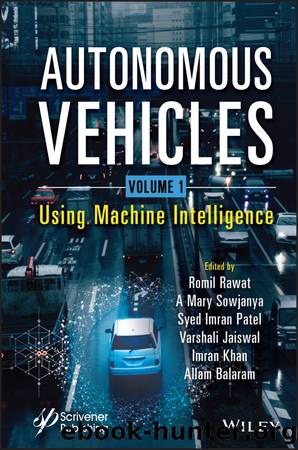Using Machine Intelligence by unknow

Author:unknow
Language: eng
Format: epub
Publisher: John Wiley & Sons, Incorporated
Published: 2022-11-26T00:00:00+00:00
8.1 Introduction
Smart cities are defined as Indian municipalities that employ information and communications technologies (ICT) to increase efficiency and productivity, share data with the public at large, and improve government services and the quality of life of its residents [1]. Data gathered from traffic sensors is crucial to the knowledge of and improvement in safety. The public road system is monitored by a variety of devices, including magnetic loops, pressure tubes, radar guns, microwave sensors, and cameras, all of which are used by modern governments for the purpose of gathering traffic data. In order to fully understand and solve the safety issue, data on street and highway accidents must be analyzed in every state and municipality [3].
The adoption of traffic surveillance systems will help all sectors, including governments, industry, and individuals, since they will be able to make better judgments based on the data gathered. For a smart city to be really successful, it has to concentrate on the well-being of its residents and visitors, as well as attracting businesses and talent, and ensuring that the environment is protected [2]. Economic benefits may be gained by making better decisions about where to invest money on safety enhancement projects thanks to accurate traffic data collection. The first stage in creating smart cities is gathering accurate data and then analyzing that data to come up with long-lasting solutions. Transportation data collection may be challenging because of the human participation and volume of data that must be analyzed, especially when video images or real traffic photography are involved.
Deep-learning, which is based on feature learning, is a method of using ml algorithms to uncover highly representative characteristics from input data that is based on feature learning (for example, an image). For object recognition, convolutional neural networks (CNNs) are the deep learning technology most often utilized [4â6]. Chen et al. [7] proposed a vehicle detection method using template matching and deep CNNs. In order to detect autos at different scales, the deep network uses convolution layers that are repeated in several sizes. Auto detection algorithm training on a GPU requires large computational resources. With CNN and sliding windows, determining the placement of stuff is a challenge [8]. A number of other approaches have been proposed to address this issue, including Sppnet [9], R-CNN [10], and Fast R-CNN [11]. On the other hand, the creation of region suggestions requires an exorbitant amount of computation time. R-CNN and Faster R-CNN [12] were created by Ren et al. with the purpose of providing the most accurate item detection accuracy while also assuring real-time detection speed. Traffic data and information study have shown that they are limited in their capacity to capture traffic data at junctions in an impartial and acceptable manner. Non-linear crossings may be difficult to monitor because of a lack of reliable traffic monitoring technologies like magnetic loops and pressure tubes as well as radar guns and microwave sensors. A lack of separate counting systems was found at orthogonal crossings, which we felt was strange. A
Download
This site does not store any files on its server. We only index and link to content provided by other sites. Please contact the content providers to delete copyright contents if any and email us, we'll remove relevant links or contents immediately.
Algorithms of the Intelligent Web by Haralambos Marmanis;Dmitry Babenko(16223)
Jquery UI in Action : Master the concepts Of Jquery UI: A Step By Step Approach by ANMOL GOYAL(9383)
Test-Driven Development with Java by Alan Mellor(7729)
Data Augmentation with Python by Duc Haba(7605)
Principles of Data Fabric by Sonia Mezzetta(7375)
Learn Blender Simulations the Right Way by Stephen Pearson(7293)
Microservices with Spring Boot 3 and Spring Cloud by Magnus Larsson(7137)
Hadoop in Practice by Alex Holmes(6585)
RPA Solution Architect's Handbook by Sachin Sahgal(6513)
The Infinite Retina by Robert Scoble Irena Cronin(6215)
Big Data Analysis with Python by Ivan Marin(5930)
Life 3.0: Being Human in the Age of Artificial Intelligence by Tegmark Max(5506)
Pretrain Vision and Large Language Models in Python by Emily Webber(4892)
Infrastructure as Code for Beginners by Russ McKendrick(4651)
Functional Programming in JavaScript by Mantyla Dan(4432)
WordPress Plugin Development Cookbook by Yannick Lefebvre(4379)
The Age of Surveillance Capitalism by Shoshana Zuboff(4240)
Embracing Microservices Design by Ovais Mehboob Ahmed Khan Nabil Siddiqui and Timothy Oleson(4146)
Applied Machine Learning for Healthcare and Life Sciences Using AWS by Ujjwal Ratan(4132)
